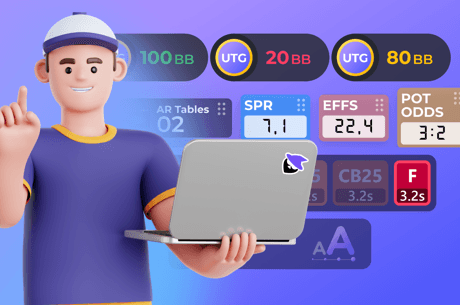10 Tips for Sit & Go Success: SNG Pros and Cons

Anyone who has played online poker even just a little knows about the popular "sit & go" tournament format.
Rather than go off at a particular time, Sit & Go tournaments (SNGs) begin once enough players have registered to fill all the seats — first you "sit," and then you "go." The sit & go is a favorite format for those who enjoy tournament poker but don't always have hours on end to devote to multi-table tournaments.
For those who enjoy SNGs and want to improve their results in them — or even if you're brand new to the format — here's a series of articles providing tips for how best to approach a sit & go and start winning some real money in them.
Introducing Sit & Gos
In this series we'll be focusing primarily on online poker sit & go format, although a lot of the discussion and advice will apply to similar formats such as live one-table satellites.
Also worth pointing out — for the most part we'll be concentrating on the very popular, "standard" single-table SNGs in which nine players begin and the top three finishers make the money (with 50/30/20 percent payouts).
There are a wide variety of multi-table sit & go tournaments available for those playing online poker, too, from two- and three-tables up to the 180-player SNGs on PokerStars (for example) that can take quite a while to complete.
While some of the same strategies we'll be covering for single-table SNGs apply to those formats, multi-table SNGs additionally involve other strategies from multi-table tournaments, in particular the different "early," middle" and "late" stage strategies discussed in our 10 Multi-Table Tournament Tips series of articles.
Also, in multi-table SNGs, more than three spots pay — for example, in a 180-man SNG on PokerStars, the top 27 finishers divide the prize pool. That fact alone obviously alters players' strategic approach significantly.
We might well think of sitting down at single-table SNG as being like starting at the "final table" of a tournament — albeit one in which only the top three spots pay. Of course, that's where the big money is for most MTTs, so we're already often geared toward doing whatever we can to make it to the "endgame" and finish in those highest-paying positions.
Today let's just get started sorting out some of the pros and cons of playing sit & gos.
Pros
1. Sit & Gos Provide Greater Flexibility Than Multi-Table Tournaments
Cash game players often regard the freedom to come and go as they please to be one of the primary benefits of playing cash versus tournaments. You can buy into a game when the mood strikes you, cash out whenever you like, and never be beholden to start times, scheduled breaks and other restrictions MTTs can impose.
But what if you prefer tournaments over cash games, as many players do? Single-table sit & gos provides a good compromise when it comes to allowing poker players to have that coveted freedom with their schedules. You can join a SNG whenever you like, and on busy sites like PokerStars, 888poker, partypoker and others it usually is only a matter of minutes (or less) before the first hands get dealt.
SNG structures vary — in fact, that will be the topic of our next article — but for the most part "standard" or non-turbo SNGs usually take around an hour to complete. That's true, for example, of the SNGs on PokerStars that feature 10-minute levels and starting stacks of 1,500 chips (75 big blinds at 10/20). Meanwhile "turbo" and "hyper-turbo" SNGs are over even faster.
Many players also like the way SNGs get you to your results relatively quickly. It's not quite like a cash game where you win or lose money each hand, but after starting a SNG you get to the finish a lot faster than in MTTs, and so you know a lot sooner whether you've won or lost money.
2. Sit & Gos Cause Less Variance Than Multi-Table Tournaments
"Variance" in poker typically refers to the up and down swings your bankroll endures — the higher the variance, the wider the swings. While sometimes used as a synonym for how much "luck" there is in a game, variance actually more specifically refers to the statistical measure of how much results can differ from expectation.
In other words, variance is not a measure of how well you play, but the volatility of the game or situation. That said, if you play a very loose and/or aggressive style, that might introduce more variance in your results than is the case for a player who is more tight.
As mentioned, in standard single-table SNGs with nine players, the top three finishers make the money. Meanwhile in multi-table tournaments only the top 10-15 percent of finishers usually cash, with some "flat" payout schedules paying as much as 20 percent. That's a lot less than in SNGs where one-third (33.3 percent) of players make the money.
Some players who find it frustrating to devote hours (or days) to MTTs only to miss the money prefer SNGs where the cashes generally come more frequently, thereby lowering their overall variance.
3. Sit & Gos Help Improve Short-Handed and Heads-Up Play
After the first few players bust a sit & go, you're already involved in "short-handed" poker (which some players prefer, anyway). And going deep in SNGs means playing a lot of heads-up as well. Those who are new to tournaments are sometimes encouraged to start out with SNGs as they give poker players a chance to practice and improve their skills when it comes to short-handed and heads-up play.
Having encountered those situations before, when they do finally break through and make an MTT final table, the shifting dynamics of short-handed play aren't going to be entirely new to those with SNG experience. That's a good thing, especially since the big payout jumps all happen among those last spots in MTTs.
Cons
1. Sit & Gos Can Feel Formulaic, Monotonous
This depends a lot on your personality and how you approach poker, generally speaking, but some players don't like that the single-table sit & go format tends to be more formulaic. That is the case in multi-table tournaments with different stages. Even some cash games can seem to provide more variety, comparatively speaking, than SNGs.
As a result, some might find the familiar, rapid march in sit & gos from the first level to short-handed play to heads-up to be somewhat monotonous. Even experienced SNG players who have developed strategies to succeed in the format sometimes will complain about the "autopilot" nature of the game.
That said, some players like familiarity and finding a game and format they feel comfortable playing and in which they can enjoy some success.
2. Sit & Gos Can Attract Tougher Opponents
This "con" really only applies to higher buy-in SNGs, as you're still going to find plenty of players in the lower-stakes and "micro" SNGs who are only average-skilled at best. Once you move up to the mid- and higher-stakes SNGs, though, you do encounter a lot of tough opponents, including some who specialize in SNGs exclusively.
You might have heard talk of some full-time, professional SNG players having honed their strategies to such an extent with "push-fold" charts and ICM (Independent Chip Model) calculators that they have "solved" SNGs. That's an interesting debate, although for most playing at the lower limits it is mostly an academic one.
It's true that across the board — at all stakes — online poker players are tougher and more knowledgeable today than was the case even just a few years ago. But there are still plenty of soft spots at the online tables, including in SNGs.
3. Sit & Gos Require Extra Study to Succeed Consistently
It doesn't matter what form of poker you play, those who wish to win consistently are benefited greatly by genuine study of the game. What some casual players of SNGs may not realize, however, is that the format does require the development of particular skill set in order to succeed on a regular basis.
Those who play SNGs frequently soon realize some players possess this skill set — one that includes a sound understanding of structures/tournament speeds, ICM applications, short-handed and heads-up strategy and more — while others do not. Those with the skills know best when to apply pressure and increase their edge versus those who don't.
SNGs can be great fun for casual or "recreational" players, and for a lot of reasons. But for those looking for a poker format in which to profit consistently, choosing SNGs means being willing to do a little extra work.
Conclusion
In some ways SNGs are a "hybrid" form combining a lot of the positives of both cash games and tournaments. That means they tend to appeal to a wider population of players than is the case with specific poker variants or tournament types.
If you're an online poker player and haven't given SNGs a try, you should. You might just find them to be a lot of fun and — if you're willing to do the work — profitable, too.
- Assessing Structures and Speeds
- Introducing the Independent Chip Model
- Practical Applications of ICM
- Early Level Play
- Middle Stage Strategy
- On the Money Bubble
- Three-Handed Play
- How To Play Heads-Up
- Managing Your SNG Bankroll
Ready to start giving sit & gos a try? Put these tips into practice at PokerStars.










